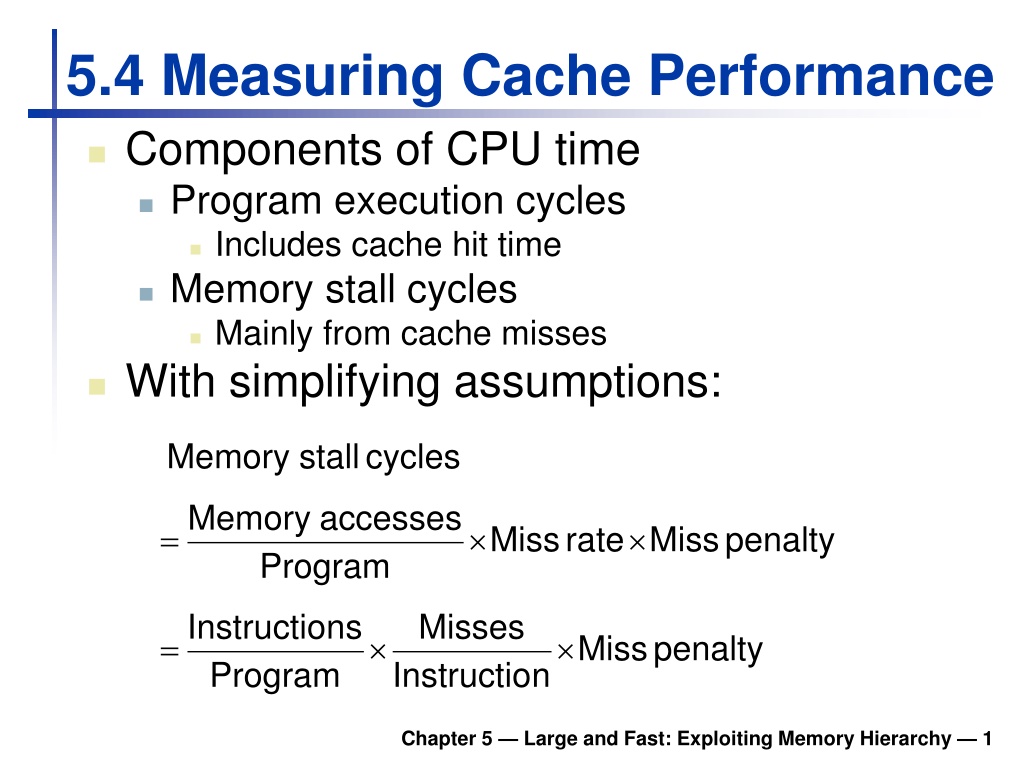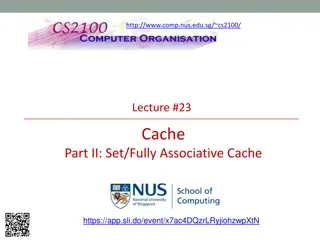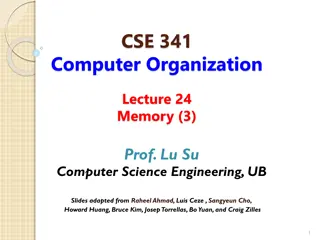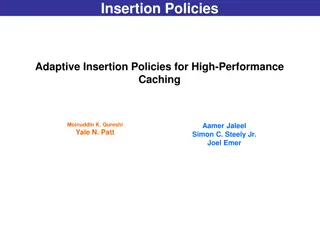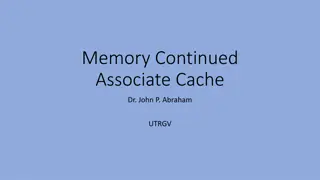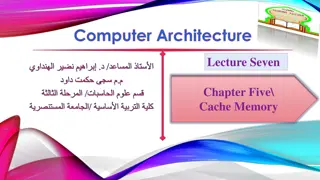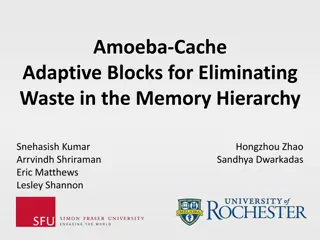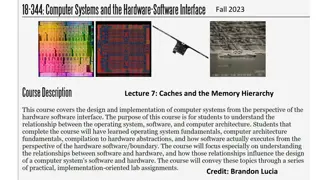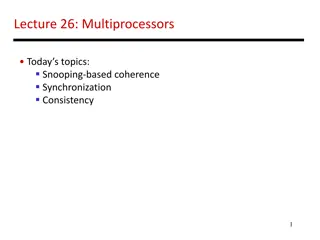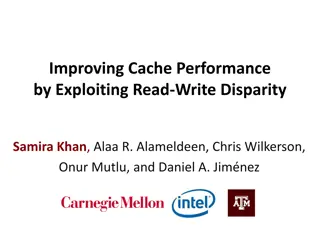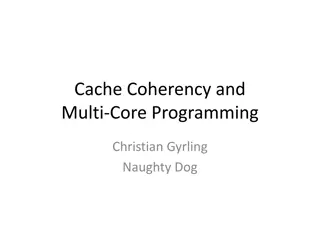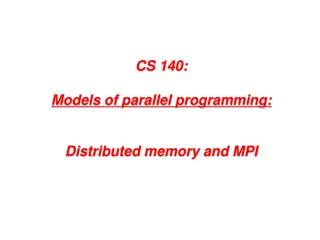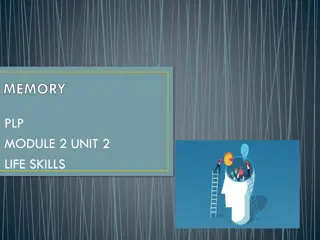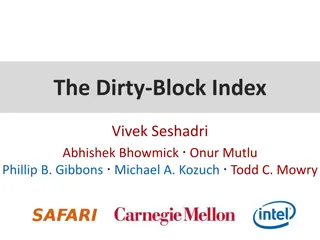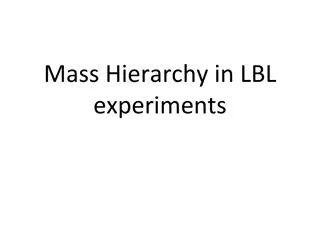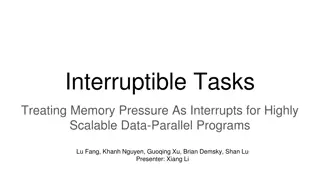Understanding Cache Performance Components and Memory Hierarchy
Exploring cache performance components, such as hit time and memory stall cycles, is crucial for evaluating system performance. By analyzing factors like miss rates and penalties, one can optimize CPU efficiency and reduce memory stalls. Associative caches offer flexible options for organizing data efficiently in memory. Delve into these concepts for a deeper understanding of memory hierarchy in computing systems.
Uploaded on Sep 27, 2024 | 0 Views
Download Presentation

Please find below an Image/Link to download the presentation.
The content on the website is provided AS IS for your information and personal use only. It may not be sold, licensed, or shared on other websites without obtaining consent from the author. Download presentation by click this link. If you encounter any issues during the download, it is possible that the publisher has removed the file from their server.
E N D
Presentation Transcript
5.4 Measuring Cache Performance Components of CPU time Program execution cycles Includes cache hit time Memory stall cycles Mainly from cache misses With simplifying assumptions: Memory stall cycles Memory accesses = Miss rate Miss penalty Program Instructio ns Misses = Miss penalty Program Instructio n Chapter 5 Large and Fast: Exploiting Memory Hierarchy 1
Cache Performance Example Given I-cache miss rate = 2% D-cache miss rate = 4% Miss penalty = 100 cycles Base CPI (ideal cache) = 2 Load & stores are 36% of instructions Miss cycles per instruction I-cache: 0.02 100 = 2 D-cache: 0.36 0.04 100 = 1.44 Actual CPI = 2 + 2 + 1.44 = 5.44 Ideal CPU is 5.44/2 =2.72 times faster What happens if the processor is faster? Chapter 5 Large and Fast: Exploiting Memory Hierarchy 2
Average Access Time Hit time is also important for performance Average memory access time (AMAT) AMAT = Hit time + Miss rate Miss penalty Example CPU with 1ns clock, hit time = 1 cycle, miss penalty = 20 cycles, I-cache miss rate = 5% AMAT = 1 + 0.05 20 = 2ns 2 cycles per instruction Chapter 5 Large and Fast: Exploiting Memory Hierarchy 3
Performance Summary When CPU performance increased Miss penalty becomes more significant Decreasing base CPI Greater proportion of time spent on memory stalls Increasing clock rate Memory stalls account for more CPU cycles Can t neglect cache behavior when evaluating system performance Chapter 5 Large and Fast: Exploiting Memory Hierarchy 4
Associative Caches Fully associative Allow a given block to go in any cache entry Requires all entries to be searched at once Comparator per entry (expensive) n-way set associative Each set contains n entries Block number determines which set (Block number) modulo (#Sets in cache) Search all entries in a given set at once n comparators (less expensive) Chapter 5 Large and Fast: Exploiting Memory Hierarchy 5
Associative Cache Example Chapter 5 Large and Fast: Exploiting Memory Hierarchy 6
Spectrum of Associativity For a cache with 8 entries Chapter 5 Large and Fast: Exploiting Memory Hierarchy 7
Associativity Example Compare 4-block caches Direct mapped, 2-way set associative, fully associative Block access sequence: 0, 8, 0, 6, 8 Direct mapped Block address 0 8 0 6 8 Cache index 0 0 0 2 0 Hit/miss Cache content after access 1 0 2 3 miss miss miss miss miss Mem[0] Mem[8] Mem[0] Mem[0] Mem[8] Mem[6] Mem[6] Chapter 5 Large and Fast: Exploiting Memory Hierarchy 8
Associativity Example 2-way set associative Block address 0 8 0 6 8 Cache index 0 0 0 0 0 Hit/miss Cache content after access Set 0 Mem[0] Mem[0] Mem[8] Mem[0] Mem[8] Mem[0] Mem[6] Mem[8] Mem[6] Set 1 miss miss hit miss miss Fully associative Block address 0 8 0 6 8 Hit/miss Cache content after access miss miss hit miss hit Mem[0] Mem[0] Mem[0] Mem[0] Mem[0] Mem[8] Mem[8] Mem[8] Mem[8] Mem[6] Mem[6] Chapter 5 Large and Fast: Exploiting Memory Hierarchy 9
How Much Associativity Increased associativity decreases miss rate But with diminishing returns Simulation of a system with 64KB D-cache, 16-word blocks, SPEC2000 1-way: 10.3% 2-way: 8.6% 4-way: 8.3% 8-way: 8.1% Chapter 5 Large and Fast: Exploiting Memory Hierarchy 10
Set Associative Cache Organization Chapter 5 Large and Fast: Exploiting Memory Hierarchy 11
Replacement Policy Direct mapped: no choice Set associative Prefer non-valid entry, if there is one Otherwise, choose among entries in the set Least-recently used (LRU) Choose the one unused for the longest time Simple for 2-way, manageable for 4-way, too hard beyond that Random Gives approximately the same performance as LRU for high associativity Chapter 5 Large and Fast: Exploiting Memory Hierarchy 12
Multilevel Caches Primary cache attached to CPU Small, but fast Level-2 cache services misses from primary cache Larger, slower, but still faster than main memory Main memory services L-2 cache misses Some high-end systems include L-3 cache Chapter 5 Large and Fast: Exploiting Memory Hierarchy 13
Multilevel Cache Example Given CPU base CPI = 1, clock rate = 4GHz Miss rate/instruction = 2% Main memory access time = 100ns With just primary cache Miss penalty = 100ns/0.25ns = 400 cycles Effective CPI = 1 + 0.02 400 = 9 Chapter 5 Large and Fast: Exploiting Memory Hierarchy 14
Example (cont.) Now add L-2 cache Access time = 5ns Global miss rate to main memory = 0.5% Primary miss with L-2 hit Penalty = 5ns/0.25ns = 20 cycles Primary miss with L-2 miss Extra penalty = 500 cycles CPI = 1 + 0.02 20 + 0.005 400 = 3.4 Performance ratio = 9/3.4 = 2.6 Chapter 5 Large and Fast: Exploiting Memory Hierarchy 15
Multilevel Cache Considerations Primary cache Focus on minimal hit time L-2 cache Focus on low miss rate to avoid main memory access Hit time has less overall impact Results L-1 cache usually smaller than a single cache L-1 block size smaller than L-2 block size Chapter 5 Large and Fast: Exploiting Memory Hierarchy 16
Interactions with Advanced CPUs Out-of-order CPUs can execute instructions during cache miss Pending store stays in load/store unit Dependent instructions wait in reservation stations Independent instructions continue Effect of miss depends on program data flow Much harder to analyse Use system simulation Chapter 5 Large and Fast: Exploiting Memory Hierarchy 17
Interactions with Software Misses depend on memory access patterns Algorithm behavior Compiler optimization for memory access Chapter 5 Large and Fast: Exploiting Memory Hierarchy 18
Software Optimization via Blocking Goal: maximize accesses to data before it is replaced Consider inner loops of DGEMM: for (int j = 0; j < n; ++j) { double cij = C[i+j*n]; for( int k = 0; k < n; k++ ) cij += A[i+k*n] * B[k+j*n]; C[i+j*n] = cij; } Chapter 5 Large and Fast: Exploiting Memory Hierarchy 19
DGEMM Access Pattern C, A, and B arrays older accesses new accesses Chapter 5 Large and Fast: Exploiting Memory Hierarchy 20
Cache Blocked DGEMM 1 #define BLOCKSIZE 32 2 void do_block (int n, int si, int sj, int sk, double *A, double 3 *B, double *C) 4 { 5 for (int i = si; i < si+BLOCKSIZE; ++i) 6 for (int j = sj; j < sj+BLOCKSIZE; ++j) 7 { 8 double cij = C[i+j*n];/* cij = C[i][j] */ 9 for( int k = sk; k < sk+BLOCKSIZE; k++ ) 10 cij += A[i+k*n] * B[k+j*n];/* cij+=A[i][k]*B[k][j] */ 11 C[i+j*n] = cij;/* C[i][j] = cij */ 12 } 13 } 14 void dgemm (int n, double* A, double* B, double* C) 15 { 16 for ( int sj = 0; sj < n; sj += BLOCKSIZE ) 17 for ( int si = 0; si < n; si += BLOCKSIZE ) 18 for ( int sk = 0; sk < n; sk += BLOCKSIZE ) 19 do_block(n, si, sj, sk, A, B, C); 20 } Chapter 5 Large and Fast: Exploiting Memory Hierarchy 21
Blocked DGEMM Access Pattern Blocked Unoptimized Chapter 5 Large and Fast: Exploiting Memory Hierarchy 22
